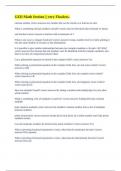GED Math Section || very Flawless.
rational number correct answers any number that can be written as a fraction or ratio
What is something rational numbers include? correct answers Decimals that terminate or repeat
unit fraction correct answers a fraction with a numerator of 1
What is one way to compare fractions? correct answers Using a number line by evenly splitting it
into the same number of sections as the denominator
Is it possible to give similar relationships between two complex numbers a+ib and c+ib? Why?
correct answers No, because the real numbers can't be identified with the complex numbers, and
there's no form of comparison between them
Can a polynomial equation be solved in the complex field? correct answers Yes
When solving a polynomial equation in the complex field, how are real zeros written? correct
answers a+i(0)
When solving a polynomial equation in the complex field, how are complex zeros written?
correct answers a+ib
When solving a polynomial equation in the complex field, how are imaginary zeros written?
correct answers ib
How are multiples found? correct answers By taking a number and multiplying it by any other
whole number
What is something a list of multiples is used for? correct answers Finding the least common
multiple
least common multiple correct answers the smallest common number from a list of multiples
between numbers
prime factorization correct answers breaks down each factor of a whole number until only prime
numbers remain
Can all composite numbers be factored into prime numbers? correct answers Yes
When converting fractional exponents to roots, what does the numerator become? correct
answers The exponent
When converting fractional exponents to roots, what does the denominator become? correct
answers The root
,Convert x⁴/⁷ to a root correct answers ⁷√x⁴
Convert y⁻³ to a fraction correct answers 1/y³
What does the exponent rule, a¹=a, mean? correct answers Any number, a, with an exponent of 1
will always equal the base, a
x³; In this example, which is the base? correct answers x
What does the exponent rule, 1ᵃ=1, mean? correct answers 1 with any exponent, will always
equal 1
What does the exponent rule, a⁰=1, mean? correct answers Any number with an exponent of
zero, will always equal 1
What does the exponent rule, (aᵐ)(aⁿ)=aᵐ⁺ⁿ, mean? correct answers When multiplying numbers
with exponents, keep the base and add the exponents
What does the exponent rule, aᵐ/aⁿ=aᵐ⁻ⁿ, mean? correct answers When dividing numbers with
exponents, keep the base and subtract the exponents
What does the exponent rule, (aᵐ)ⁿ=aᵐ⁽ⁿ⁾, mean? correct answers When a number with an
exponent has another exponent outside of the parenthesis, keep the base and multiply the
exponents
What does the exponent rule, (a(b))ᵐ=aᵐ(bᵐ), mean? correct answers When two numbers being
multiplied within parenthesis has an exponent outside of the parenthesis, the two numbers can be
multiplied outside of the parenthesis with both numbers having the same exponent as before
What does the exponent rule, (ᵃ⁄b)ᵐ=aᵐ/bᵐ, mean? correct answers When two numbers being
divided within parenthesis has an exponent outside of the parenthesis, the two numbers can be
divided outside of the parenthesis with numbers having the same exponent as before
Which numbers can be an exponent? correct answers All numbers, including fractions
absolute value correct answers a number's distance from zero
What does the absolute value of numbers imply? correct answers That subtraction can be thought
of as flipping the sign of the number following the subtraction sign and simply adding the two
numbers
When there are more than two numbers in a multiplication or division problem, how do you
know if the answer is positive or negative? correct answers The product or quotient is negative if
there's an odd amount of negatives, and the product or quotient is positive if there's an even
amount of negatives
, dividend correct answers The number in front of the division sign
divisor correct answers The number after the division sign
decimal system correct answers A way of writing out numbers that uses ten different numerals
(aka "base 10" system); other base numbers can be used
Can every rational number be written as a terminating decimal or as a repeating decimal? correct
answers Yes
When multiplying decimals, where do you place the decimal in your answer? correct answers
Count the number of decimal places in the original problem, then use that total to place the
decimal the same number of places over in your answer, from right to left
Is dividing decimals by a whole number the same as multiplying decimals? correct answers Yes
What does dividing two decimals require? correct answers Changing the divisor to a whole
number by moving its decimal point, then, the decimal place of the dividend should be moved
the same number of places as the divisor, lastly, solve the same way you multiply decimals
If the dividend isn't a decimal, how do you solve the problem? correct answers The same way as
dividing two decimals
Commutative Property of Addition correct answers a+b=b+a
Commutative Property of Multiplication correct answers a(b)=b(a)
Associative Property of Addition correct answers (a+b)+c=a+(b+c)
Associative Property of Multiplication correct answers (ab)c=a(bc)
Identity Property of Addition correct answers a+0=a; 0+a=a
Identity Property of Multiplication correct answers a(1)=a; 1(a)=a
Inverse Property of Addition correct answers a+(-a)=0
Inverse Property of Multiplication correct answers a(1/a)=1; a╪0
Distribution Property correct answers a(b+c)=ab+ac
What does the inverse property of addition state? correct answers That the sum of a number and
it's opposite equals zero
What does the inverse property of multiplication state? correct answers That the product of a
number (other than zero) and it's reciprocal equals one




